CHAIR OF PEDIATRICTS WITH MEDICAL GENETICS LECTURE SUBJECT

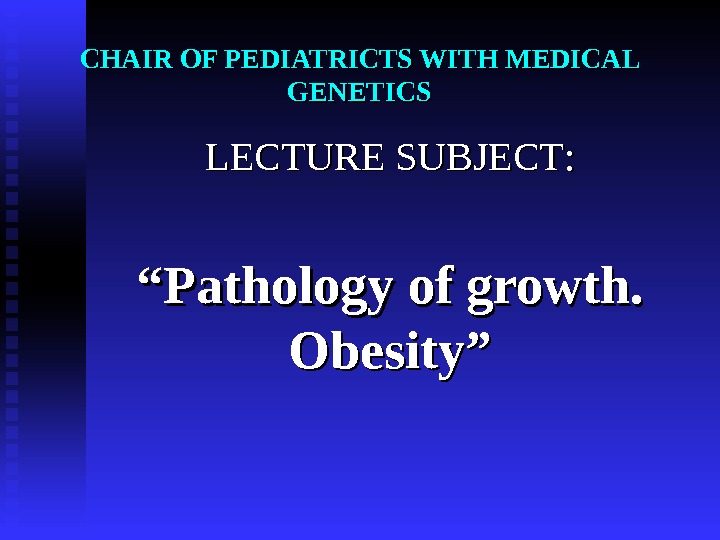
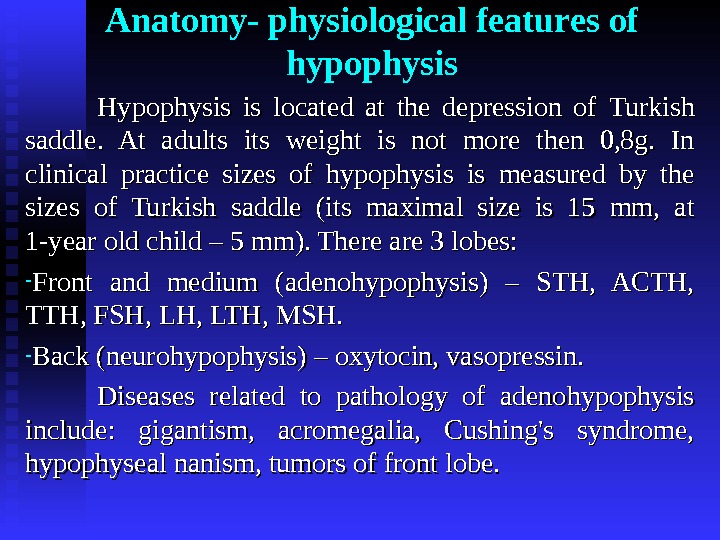
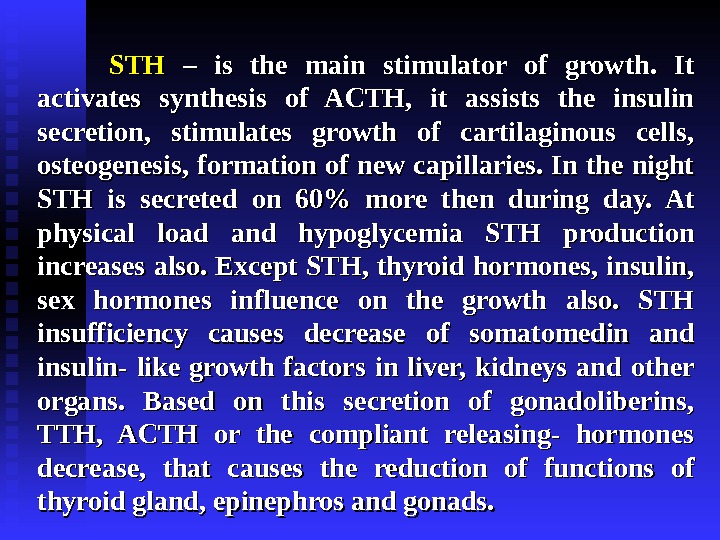
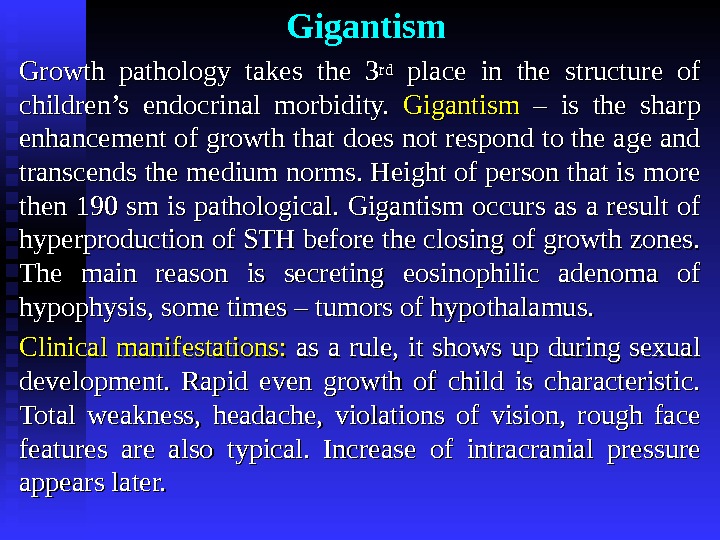
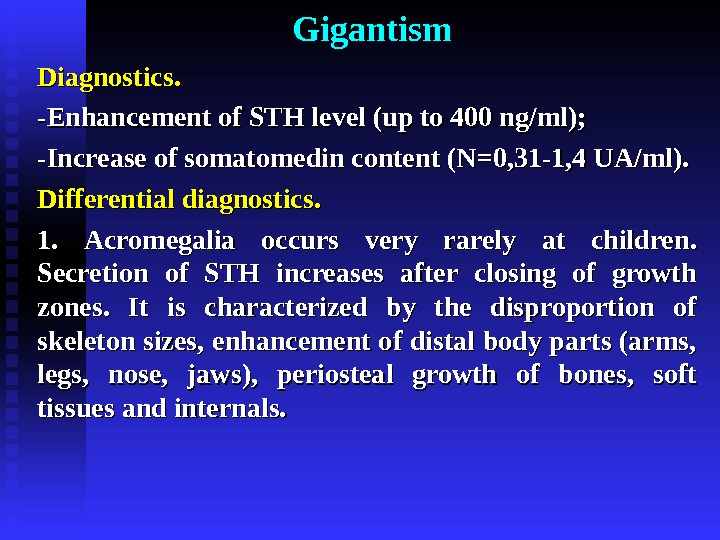
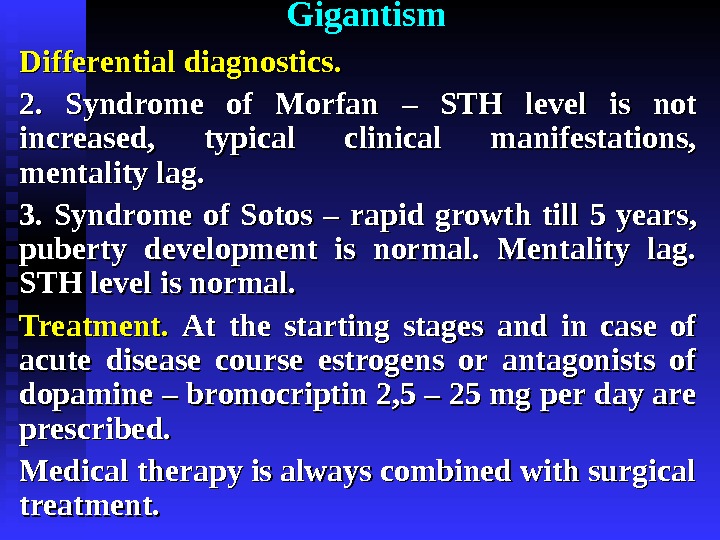
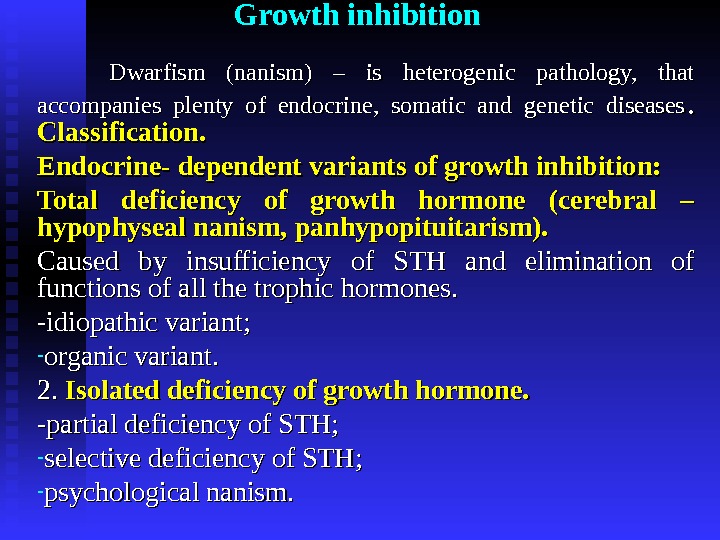
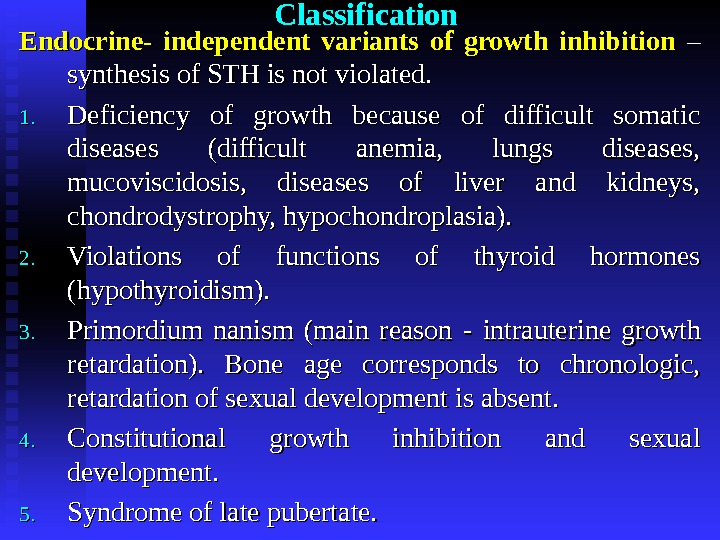
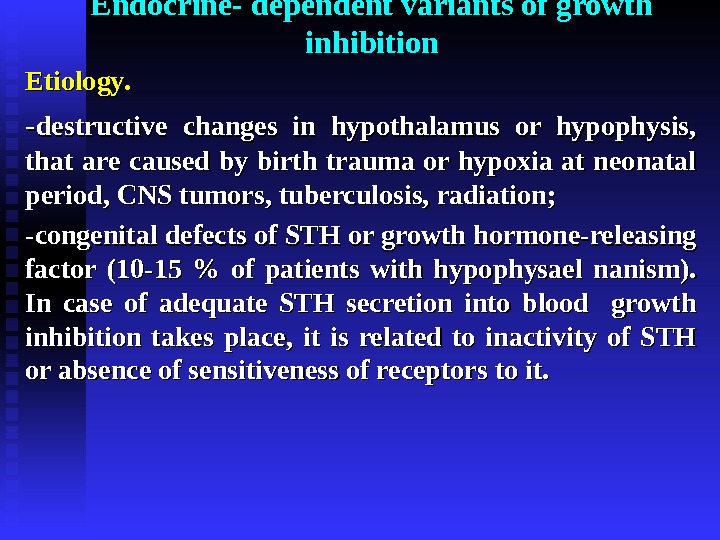
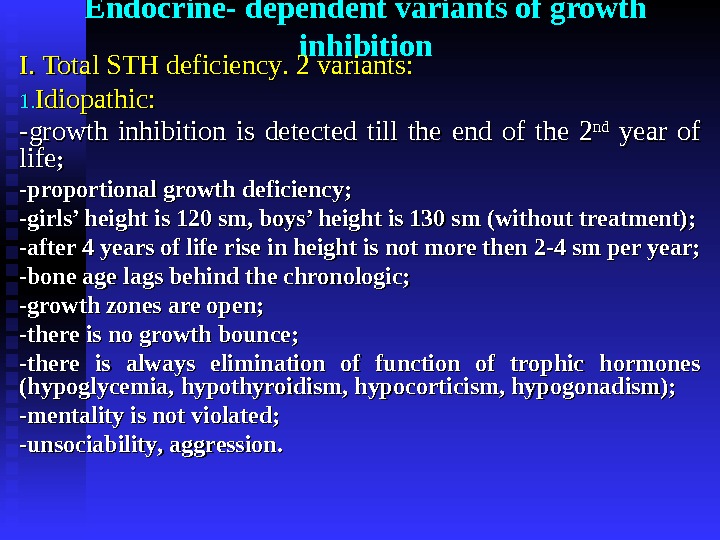
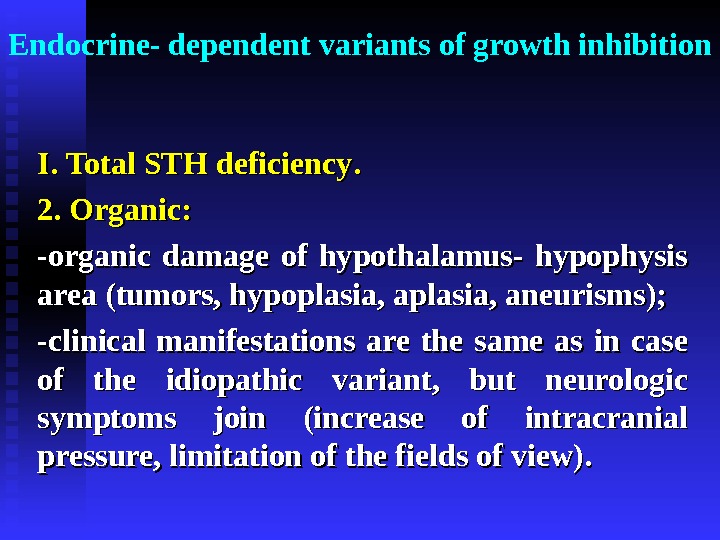
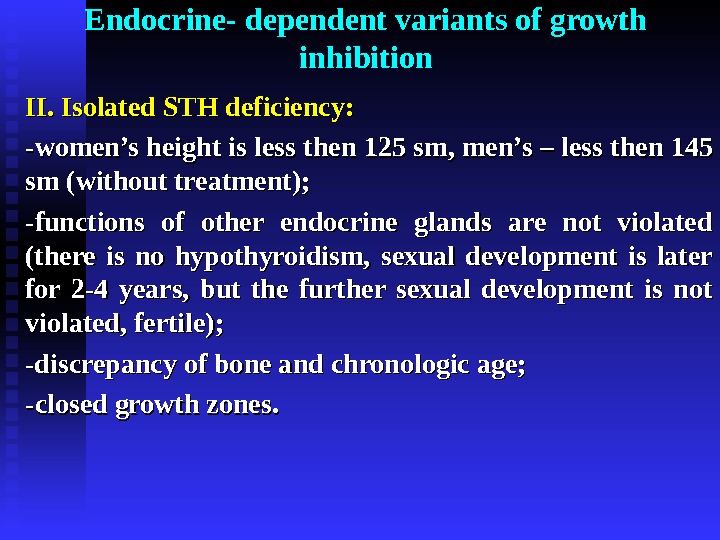
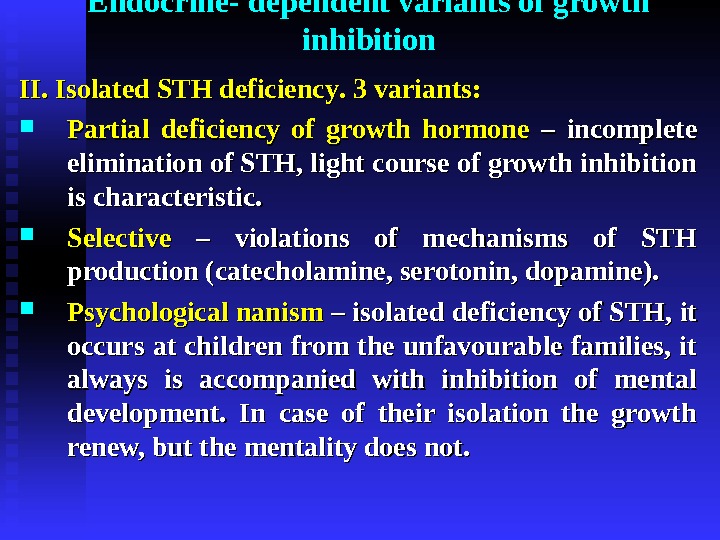
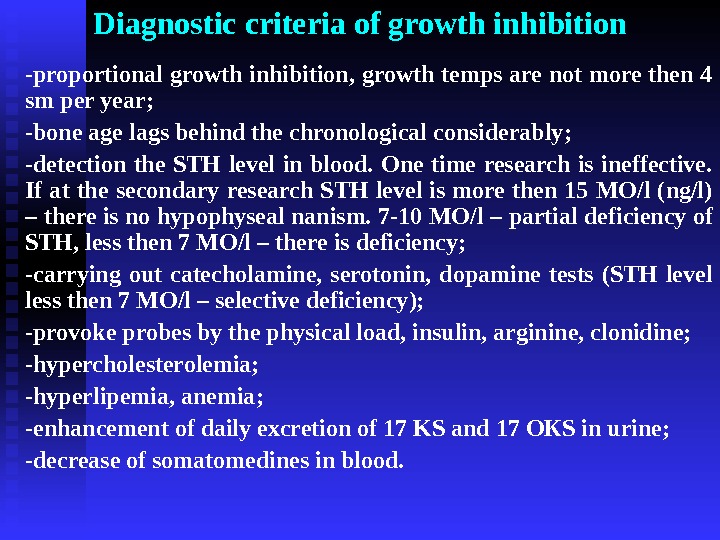
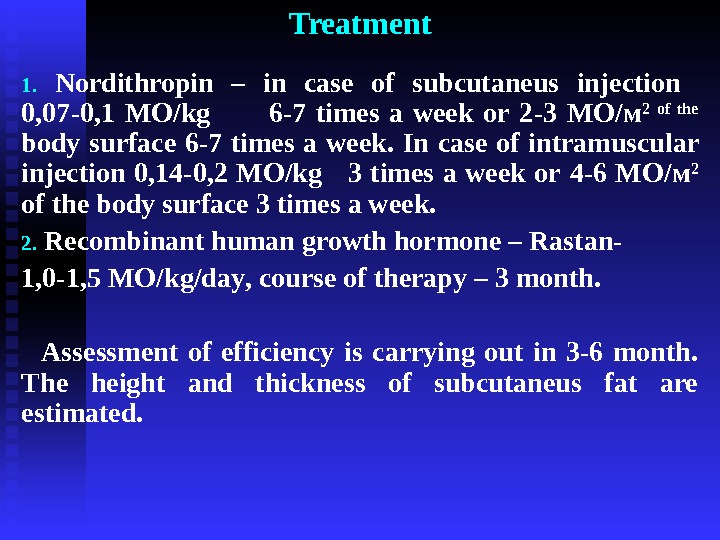
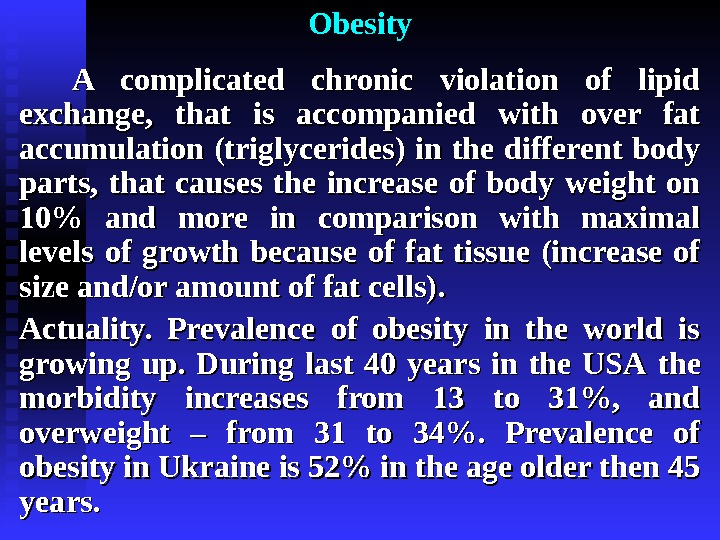
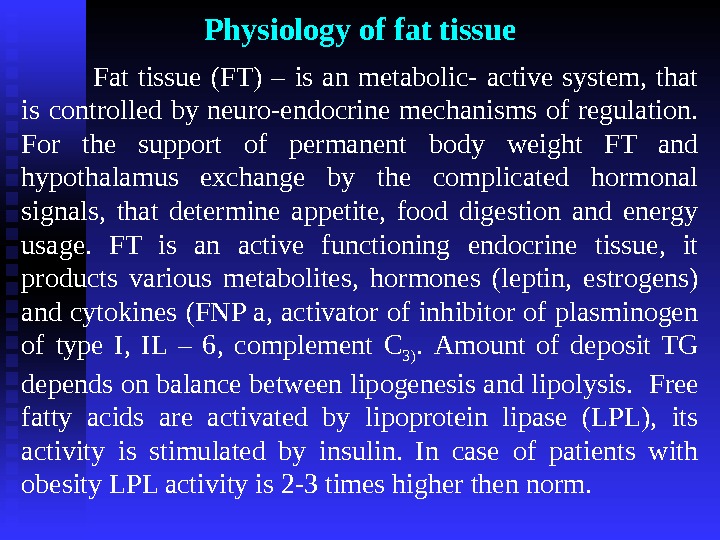
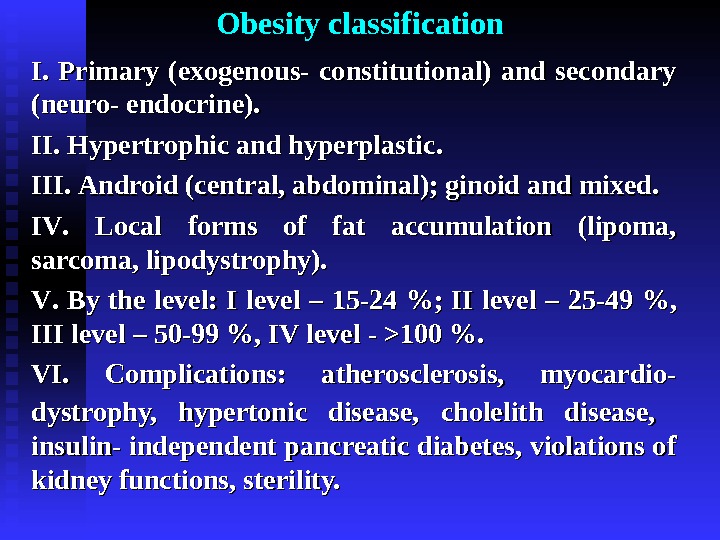
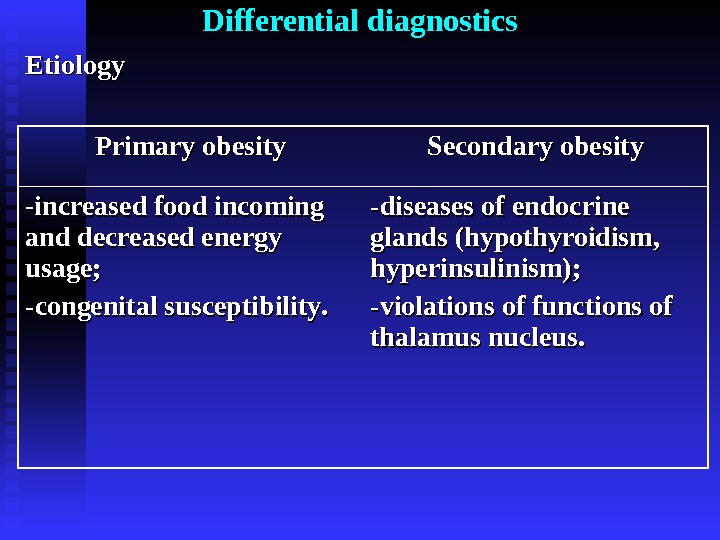
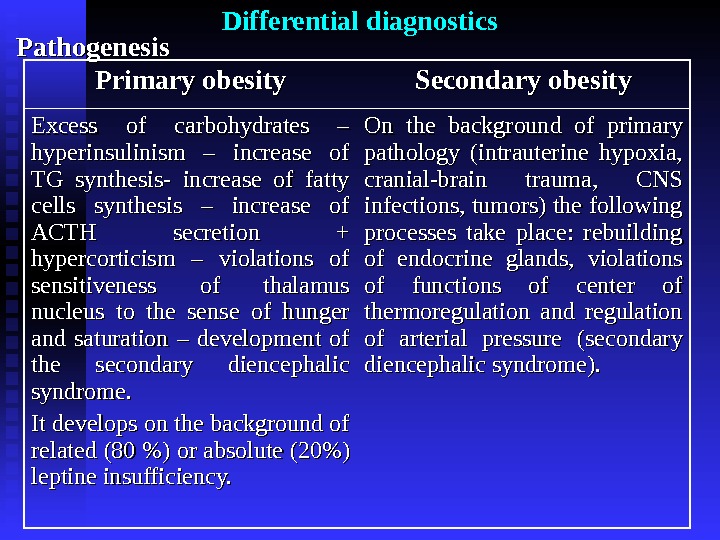
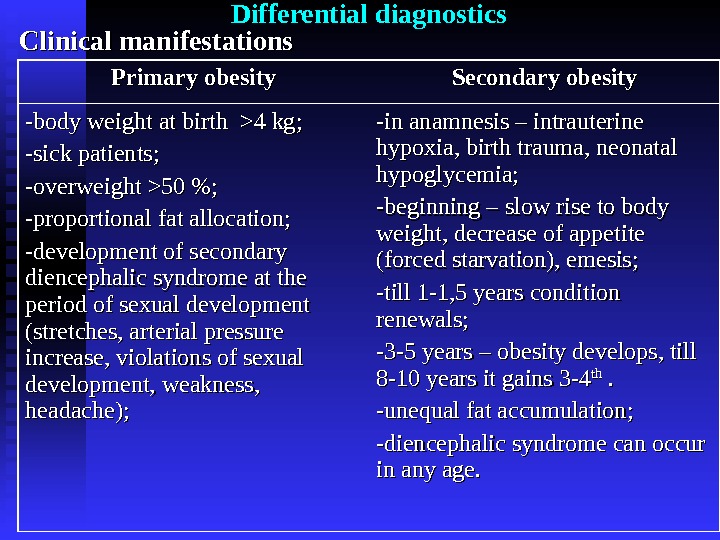
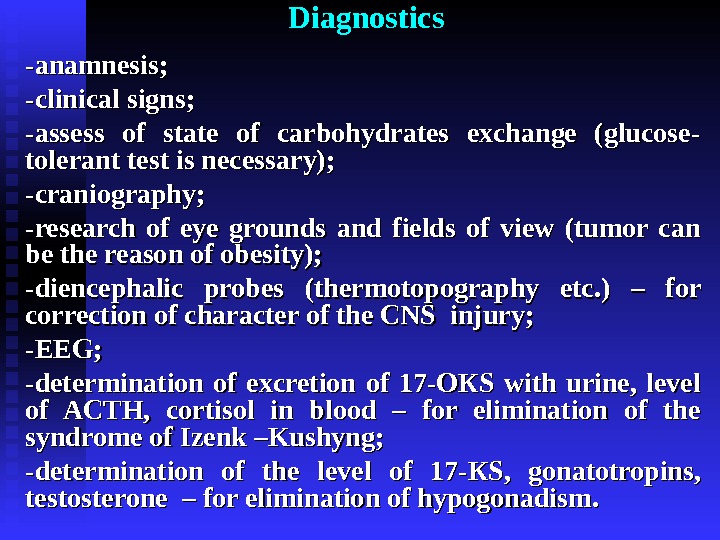
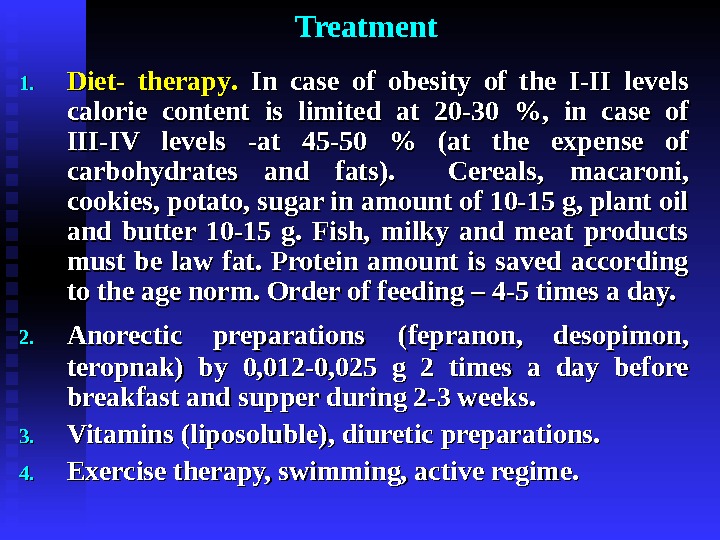

english_patologiya_rosta1.oghirenie.ppt
- Размер: 101.5 Кб
- Количество слайдов: 24
Описание презентации CHAIR OF PEDIATRICTS WITH MEDICAL GENETICS LECTURE SUBJECT по слайдам
 CHAIR OF PEDIATRICTS WITH MEDICAL GENETICS LECTURE SUBJECT : : ““ Pathology of growth. Obesity ””
CHAIR OF PEDIATRICTS WITH MEDICAL GENETICS LECTURE SUBJECT : : ““ Pathology of growth. Obesity ””
 Anatomy- physiological features of hypophysis Hypophysis is located at the depression of Turkish saddle. At adults its weight is not more then 0, 8 g. In clinical practice sizes of hypophysis is measured by the sizes of Turkish saddle (its maximal size is 15 mm, at 1 -year old child – 5 mm). There are 3 lobes: — Front and medium (adenohypophysis) – STH, ACTH, TTH, FSH, LH, LTH, MSH. — Back (neurohypophysis) – oxytocin, vasopressin. Diseases related to pathology of adenohypophysis include: gigantism, acromegalia, Cushing’s syndrome, hypophyseal nanism, tumors of front lobe.
Anatomy- physiological features of hypophysis Hypophysis is located at the depression of Turkish saddle. At adults its weight is not more then 0, 8 g. In clinical practice sizes of hypophysis is measured by the sizes of Turkish saddle (its maximal size is 15 mm, at 1 -year old child – 5 mm). There are 3 lobes: — Front and medium (adenohypophysis) – STH, ACTH, TTH, FSH, LH, LTH, MSH. — Back (neurohypophysis) – oxytocin, vasopressin. Diseases related to pathology of adenohypophysis include: gigantism, acromegalia, Cushing’s syndrome, hypophyseal nanism, tumors of front lobe.
 STHSTH – – is the main stimulator of growth. It activates synthesis of ACTH, it assists the insulin secretion, stimulates growth of cartilaginous cells, osteogenesis, formation of new capillaries. In the night STH is secreted on 60% more then during day. At physical load and hypoglycemia STH production increases also. Except STH, thyroid hormones, insulin, sex hormones influence on the growth also. STH insufficiency causes decrease of somatomedin and insulin- like growth factors in liver, kidneys and other organs. Based on this secretion of gonadoliberins, TTH, ACTH or the compliant releasing- hormones decrease, that causes the reduction of functions of thyroid gland , , epinephros and gonads. .
STHSTH – – is the main stimulator of growth. It activates synthesis of ACTH, it assists the insulin secretion, stimulates growth of cartilaginous cells, osteogenesis, formation of new capillaries. In the night STH is secreted on 60% more then during day. At physical load and hypoglycemia STH production increases also. Except STH, thyroid hormones, insulin, sex hormones influence on the growth also. STH insufficiency causes decrease of somatomedin and insulin- like growth factors in liver, kidneys and other organs. Based on this secretion of gonadoliberins, TTH, ACTH or the compliant releasing- hormones decrease, that causes the reduction of functions of thyroid gland , , epinephros and gonads. .
 Gigantism Growth pathology takes the 3 rdrd place in the structure of children’s endocrinal morbidity. Gigantism – – is the sharp enhancement of growth that does not respond to the age and transcend s the medium norms. Height of person that is more then 190 sm is pathological. Gigantism occurs as a result of hyperproduction of STH before the closing of growth zones. The main reason is secreting eosinophilic adenoma of hypophysis, some times – tumors of hypothalamus. Clinical manifestations : : as a rule, it shows up during sexual development. Rapid even growth of child is characteristic. Total weakness, headache, violations of vision, rough face features are also typical. Increase of intracranial pressure appears later.
Gigantism Growth pathology takes the 3 rdrd place in the structure of children’s endocrinal morbidity. Gigantism – – is the sharp enhancement of growth that does not respond to the age and transcend s the medium norms. Height of person that is more then 190 sm is pathological. Gigantism occurs as a result of hyperproduction of STH before the closing of growth zones. The main reason is secreting eosinophilic adenoma of hypophysis, some times – tumors of hypothalamus. Clinical manifestations : : as a rule, it shows up during sexual development. Rapid even growth of child is characteristic. Total weakness, headache, violations of vision, rough face features are also typical. Increase of intracranial pressure appears later.
 Gigantism Diagnostics. — Enhancement of STH level (up to 400 ng/ml); — Increase of somatomedin content (N =0, 31 -1, 4 UA/ml ). ). Differential diagnostics. . 1. 1. Acromegalia occurs very rarely at children. Secretion of STH increases after closing of growth zones. It is characterized by the disproportion of skeleton sizes, enhancement of distal body parts (arms, legs, nose, jaws), periosteal growth of bones, soft tissues and internals.
Gigantism Diagnostics. — Enhancement of STH level (up to 400 ng/ml); — Increase of somatomedin content (N =0, 31 -1, 4 UA/ml ). ). Differential diagnostics. . 1. 1. Acromegalia occurs very rarely at children. Secretion of STH increases after closing of growth zones. It is characterized by the disproportion of skeleton sizes, enhancement of distal body parts (arms, legs, nose, jaws), periosteal growth of bones, soft tissues and internals.
 Gigantism Differential diagnostics. . 2. 2. Syndrome of Morfan – – STH level is not increased, typical clinical manifestations, mentality laglag. . 3. 3. Syndrome of Sotos – – rapid growth till 5 years, puberty development is normal. Mentality lag. STH level is normal. Treatment. . At the starting stages and in case of acute disease course estrogens or antagonists of dopamine – bromocriptin 2, 5 – 25 mg per day are prescribed. Medical therapy is always combined with surgical treatment.
Gigantism Differential diagnostics. . 2. 2. Syndrome of Morfan – – STH level is not increased, typical clinical manifestations, mentality laglag. . 3. 3. Syndrome of Sotos – – rapid growth till 5 years, puberty development is normal. Mentality lag. STH level is normal. Treatment. . At the starting stages and in case of acute disease course estrogens or antagonists of dopamine – bromocriptin 2, 5 – 25 mg per day are prescribed. Medical therapy is always combined with surgical treatment.
 Growth inhibition DD warfism (nanism) – is heterogenic pathology, that accompanies plenty of endocrine, somatic and genetic diseases. . Classification. Endocrine- dependent variants of growth inhibition: Total deficiency of growth hormone (cerebral – hypophyseal nanism, panhypopituitarism ). ). Caused by insufficiency of STH and elimination of functions of all the trophic hormones. -idiopathic variant ; ; — organic variant. . 2. 2. ІІ solated deficiency of growth hormone. -partial deficiency of STH; — selective deficiency of STH ; ; — psychological nanism.
Growth inhibition DD warfism (nanism) – is heterogenic pathology, that accompanies plenty of endocrine, somatic and genetic diseases. . Classification. Endocrine- dependent variants of growth inhibition: Total deficiency of growth hormone (cerebral – hypophyseal nanism, panhypopituitarism ). ). Caused by insufficiency of STH and elimination of functions of all the trophic hormones. -idiopathic variant ; ; — organic variant. . 2. 2. ІІ solated deficiency of growth hormone. -partial deficiency of STH; — selective deficiency of STH ; ; — psychological nanism.
 Classification Endocrine- independent variants of growth inhibition – – synthesis of STH is not violated. 1. 1. Deficiency of growth because of difficult somatic diseases (difficult anemia, lungs diseases, mucoviscidosis, diseases of liver and kidneys, chondrodystrophy, hypochondroplasia). 2. 2. Violations of functions of thyroid hormones (hypothyroidism). 3. 3. Primordium nanism (main reason — intrauterine growth retardation ). Bone age corresponds to chronologic, retardation of sexual development is absent. 4. 4. Constitutional growth inhibition and sexual development. 5. 5. Syndrome of late pubertate. 6. 6. Syndrome of Shershevskiy – Terner.
Classification Endocrine- independent variants of growth inhibition – – synthesis of STH is not violated. 1. 1. Deficiency of growth because of difficult somatic diseases (difficult anemia, lungs diseases, mucoviscidosis, diseases of liver and kidneys, chondrodystrophy, hypochondroplasia). 2. 2. Violations of functions of thyroid hormones (hypothyroidism). 3. 3. Primordium nanism (main reason — intrauterine growth retardation ). Bone age corresponds to chronologic, retardation of sexual development is absent. 4. 4. Constitutional growth inhibition and sexual development. 5. 5. Syndrome of late pubertate. 6. 6. Syndrome of Shershevskiy – Terner.
 Endocrine- dependent variants of growth inhibition Etiology. . — destructive changes in hypothalamus or hypophysis, that are caused by birth trauma or hypoxia at neonatal period, CNS tumors, tuberculosis, radiation; — congenital defects of STH or growth hormone-releasing factor ( 10 -15 % of patients with hypophysael nanism). In case of adequate STH secretion into blood growth inhibition takes place, it is related to inactivity of STH or absence of sensitiveness of receptors to it.
Endocrine- dependent variants of growth inhibition Etiology. . — destructive changes in hypothalamus or hypophysis, that are caused by birth trauma or hypoxia at neonatal period, CNS tumors, tuberculosis, radiation; — congenital defects of STH or growth hormone-releasing factor ( 10 -15 % of patients with hypophysael nanism). In case of adequate STH secretion into blood growth inhibition takes place, it is related to inactivity of STH or absence of sensitiveness of receptors to it.
 Endocrine- dependent variants of growth inhibition І. І. Total STH deficiency. 2. 2 variants : : 1. 1. Idiopathic : : — growth inhibition is detected till the end of the 2 ndnd year of life ; ; — proportional growth deficiency ; ; — girls’ height is 120 sm, boys’ height is 130 sm (without treatment); -after 4 years of life rise in height is not more then 2 -4 sm per year; — bone age lags behind the chronologic; — growth zones are open; — there is no growth bounce ; ; — there is always elimination of function of trophic hormones (hypoglycemia, hypothyroidism, hypocorticism, hypogonadism); — mentality is not violated ; ; -unsociability , aggression.
Endocrine- dependent variants of growth inhibition І. І. Total STH deficiency. 2. 2 variants : : 1. 1. Idiopathic : : — growth inhibition is detected till the end of the 2 ndnd year of life ; ; — proportional growth deficiency ; ; — girls’ height is 120 sm, boys’ height is 130 sm (without treatment); -after 4 years of life rise in height is not more then 2 -4 sm per year; — bone age lags behind the chronologic; — growth zones are open; — there is no growth bounce ; ; — there is always elimination of function of trophic hormones (hypoglycemia, hypothyroidism, hypocorticism, hypogonadism); — mentality is not violated ; ; -unsociability , aggression.
 Endocrine- dependent variants of growth inhibition І. І. Total STH deficiency. . 2. 2. Organic : : — organic damage of hypothalamus- hypophysis area (tumors, hypoplasia, aplasia, aneurisms); — clinical manifestations are the same as in case of the idiopathic variant, but neurologic symptoms join (increase of intracranial pressure, limitation of the fields of view).
Endocrine- dependent variants of growth inhibition І. І. Total STH deficiency. . 2. 2. Organic : : — organic damage of hypothalamus- hypophysis area (tumors, hypoplasia, aplasia, aneurisms); — clinical manifestations are the same as in case of the idiopathic variant, but neurologic symptoms join (increase of intracranial pressure, limitation of the fields of view).
 Endocrine- dependent variants of growth inhibition ІІ. Isolated STH deficiency : : — women’s height is less then 125 sm, men’s – less then 145 sm (without treatment) ; ; — functions of other endocrine glands are not violated (there is no hypothyroidism, sexual development is later for 2 -4 years, but the further sexual development is not violated, fertile); -discrepancy of bone and chronologic age; — closed growth zones.
Endocrine- dependent variants of growth inhibition ІІ. Isolated STH deficiency : : — women’s height is less then 125 sm, men’s – less then 145 sm (without treatment) ; ; — functions of other endocrine glands are not violated (there is no hypothyroidism, sexual development is later for 2 -4 years, but the further sexual development is not violated, fertile); -discrepancy of bone and chronologic age; — closed growth zones.
 Endocrine- dependent variants of growth inhibition ІІ. Isolated STH deficiency. 3. 3 variants : : Partial deficiency of growth hormone – – incomplete elimination of STH, light course of growth inhibition is characteristic. Selective – – violations of mechanisms of STH production (catecholamine, serotonin, dopamine). Psychological nanism – – isolated deficiency of STH, it occurs at children from the unfavourable families, it always is accompanied with inhibition of mental development. In case of their isolation the growth renew, but the mentality does not.
Endocrine- dependent variants of growth inhibition ІІ. Isolated STH deficiency. 3. 3 variants : : Partial deficiency of growth hormone – – incomplete elimination of STH, light course of growth inhibition is characteristic. Selective – – violations of mechanisms of STH production (catecholamine, serotonin, dopamine). Psychological nanism – – isolated deficiency of STH, it occurs at children from the unfavourable families, it always is accompanied with inhibition of mental development. In case of their isolation the growth renew, but the mentality does not.
 Diagnostic criteria of growth inhibition — proportional growth inhibition, growth temps are not more then 4 sm per year; — bone age lags behind the chronological considerably ; — detection the STH level in blood. One time research is ineffective. If at the secondary research STH level is more then 15 MO/l (ng/l) – there is no hypophyseal nanism. 7 -10 М О /l – partial deficiency of STH, less then 7 МО /l – there is deficiency ; — carrying out catecholamine, serotonin, dopamine tests (STH level less then 7 МО /l – selective deficiency ); — provoke probes by the physical load, insulin, arginine, clonidine; — hypercholesterolemia; — hyperlipemia, anemia ; — enhancement of daily excretion of 17 KS and 17 ОК S in urine ; — decrease of somatomedines in blood.
Diagnostic criteria of growth inhibition — proportional growth inhibition, growth temps are not more then 4 sm per year; — bone age lags behind the chronological considerably ; — detection the STH level in blood. One time research is ineffective. If at the secondary research STH level is more then 15 MO/l (ng/l) – there is no hypophyseal nanism. 7 -10 М О /l – partial deficiency of STH, less then 7 МО /l – there is deficiency ; — carrying out catecholamine, serotonin, dopamine tests (STH level less then 7 МО /l – selective deficiency ); — provoke probes by the physical load, insulin, arginine, clonidine; — hypercholesterolemia; — hyperlipemia, anemia ; — enhancement of daily excretion of 17 KS and 17 ОК S in urine ; — decrease of somatomedines in blood.
 Treatment 1. Nordithropin – in case of subcutaneus injection 0, 07 -0, 1 МО /kg 6 -7 times a week or 2 -3 МО / м 2 of the body surface 6 -7 times a week. In case of intramuscular injection 0, 14 -0, 2 МО /kg 3 times a week or 4 -6 МО / м 2 of the body surface 3 times a week. 2. Recombinant human growth hormone – Rastan- 1, 0 -1, 5 МО /kg/day , course of therapy – 3 month. Assessment of efficiency is carrying out in 3 -6 month. The height and thickness of subcutaneus fat are estimated.
Treatment 1. Nordithropin – in case of subcutaneus injection 0, 07 -0, 1 МО /kg 6 -7 times a week or 2 -3 МО / м 2 of the body surface 6 -7 times a week. In case of intramuscular injection 0, 14 -0, 2 МО /kg 3 times a week or 4 -6 МО / м 2 of the body surface 3 times a week. 2. Recombinant human growth hormone – Rastan- 1, 0 -1, 5 МО /kg/day , course of therapy – 3 month. Assessment of efficiency is carrying out in 3 -6 month. The height and thickness of subcutaneus fat are estimated.
 Obesity A complicated chronic violation of lipid exchange, that is accompanied with over fat accumulation (triglycerides) in the different body parts, that causes the increase of body weight on 10% and more in comparison with maximal levels of growth because of fat tissue (increase of size and/or amount of fat cells). Actuality. Prevalence of obesity in the world is growing up. During last 40 years in the USA the morbidity increases from 13 to 31%, and overweight – from 31 to 34%. Prevalence of obesity in Ukraine is 52% in the age older then 45 years.
Obesity A complicated chronic violation of lipid exchange, that is accompanied with over fat accumulation (triglycerides) in the different body parts, that causes the increase of body weight on 10% and more in comparison with maximal levels of growth because of fat tissue (increase of size and/or amount of fat cells). Actuality. Prevalence of obesity in the world is growing up. During last 40 years in the USA the morbidity increases from 13 to 31%, and overweight – from 31 to 34%. Prevalence of obesity in Ukraine is 52% in the age older then 45 years.
 Physiology of fat tissue Fat tissue (FT) – is an metabolic- active system, that is controlled by neuro-endocrine mechanisms of regulation. For the support of permanent body weight FT and hypothalamus exchange by the complicated hormonal signals, that determine appetite, food digestion and energy usage. FT is an active functioning endocrine tissue, it products various metabolites, hormones (leptin, estrogens) and cytokines (FNP a, activator of inhibitor of plasminogen of type I, IL – 6 , complement С 3). Amount of deposit TG depends on balance between lipogenesis and lipolysis. Free fatty acids are activated by lipoprotein lipase (LPL), its activity is stimulated by insulin. In case of patients with obesity LPL activity is 2 -3 times higher then norm.
Physiology of fat tissue Fat tissue (FT) – is an metabolic- active system, that is controlled by neuro-endocrine mechanisms of regulation. For the support of permanent body weight FT and hypothalamus exchange by the complicated hormonal signals, that determine appetite, food digestion and energy usage. FT is an active functioning endocrine tissue, it products various metabolites, hormones (leptin, estrogens) and cytokines (FNP a, activator of inhibitor of plasminogen of type I, IL – 6 , complement С 3). Amount of deposit TG depends on balance between lipogenesis and lipolysis. Free fatty acids are activated by lipoprotein lipase (LPL), its activity is stimulated by insulin. In case of patients with obesity LPL activity is 2 -3 times higher then norm.
 Obesity classification І. І. Primary (exogenous- constitutional) and secondary (neuro- endocrine). ІІ. Hypertrophic and hyperplastic. . ІІІ. Android (( central, abdominal); ginoid and mixed. ІІ VV. . Local forms of fat accumulation (lipoma, sarcoma, lipodystrophy). VV. . By the level: І І level – 15 -24 %; ІІ level – 25 -49 %, ІІІ level – 50 -99 %, І VV level — — >> 100 %. VIVI. . Complications: atherosclerosis, myocardio- dystrophy, hypertonic disease, cholelith disease, insulin- independent pancreatic diabetes, violations of kidney functions, sterility.
Obesity classification І. І. Primary (exogenous- constitutional) and secondary (neuro- endocrine). ІІ. Hypertrophic and hyperplastic. . ІІІ. Android (( central, abdominal); ginoid and mixed. ІІ VV. . Local forms of fat accumulation (lipoma, sarcoma, lipodystrophy). VV. . By the level: І І level – 15 -24 %; ІІ level – 25 -49 %, ІІІ level – 50 -99 %, І VV level — — >> 100 %. VIVI. . Complications: atherosclerosis, myocardio- dystrophy, hypertonic disease, cholelith disease, insulin- independent pancreatic diabetes, violations of kidney functions, sterility.
 Differential diagnostics Etiology Primary obesity Secondary obesity — increased food incoming and decreased energy usage ; ; — congenital susceptibility. . — diseases of endocrine glands (hypothyroidism, hyperinsulinism); — violations of functions of thalamus nucleus.
Differential diagnostics Etiology Primary obesity Secondary obesity — increased food incoming and decreased energy usage ; ; — congenital susceptibility. . — diseases of endocrine glands (hypothyroidism, hyperinsulinism); — violations of functions of thalamus nucleus.
 Differential diagnostics Pathogenesis Primary obesity Secondary obesity Excess of carbohydrates – hyperinsulinism – increase of TG synthesis- increase of fatty cells synthesis – increase of ACTH secretion + hypercorticism – violations of sensitiveness of thalamus nucleus to the sense of hunger and saturation – development of the secondary diencephalic syndrome. It develops on the background of related (80 %) or absolute (20%) leptine insufficiency. On the background of primary pathology (intrauterine hypoxia, cranial-brain trauma, CNS infections, tumors) the following processes take place: rebuilding of endocrine glands, violations of functions of center of thermoregulation and regulation of arterial pressure (secondary diencephalic syndrome).
Differential diagnostics Pathogenesis Primary obesity Secondary obesity Excess of carbohydrates – hyperinsulinism – increase of TG synthesis- increase of fatty cells synthesis – increase of ACTH secretion + hypercorticism – violations of sensitiveness of thalamus nucleus to the sense of hunger and saturation – development of the secondary diencephalic syndrome. It develops on the background of related (80 %) or absolute (20%) leptine insufficiency. On the background of primary pathology (intrauterine hypoxia, cranial-brain trauma, CNS infections, tumors) the following processes take place: rebuilding of endocrine glands, violations of functions of center of thermoregulation and regulation of arterial pressure (secondary diencephalic syndrome).
 Differential diagnostics Clinical manifestations Primary obesity Secondary obesity — body weight at birth >> 44 kg kg ; ; — sick patients ; ; — overweight >> 50 %; — proportional fat allocation; — development of secondary diencephalic syndrome at the period of sexual development (( stretches, arterial pressure increase, violations of sexual development, weakness, headache); — in anamnesis – intrauterine hypoxia, birth trauma, neonatal hypoglycemia; — beginning – slow rise to body weight, decrease of appetite (forced starvation), emesis; — till 1 -1, 5 years condition renewals; -3 -5 years – obesity develops, till 8 -10 years it gains 3 -4 thth . . — unequal fat accumulation; — diencephalic syndrome can occur in any age.
Differential diagnostics Clinical manifestations Primary obesity Secondary obesity — body weight at birth >> 44 kg kg ; ; — sick patients ; ; — overweight >> 50 %; — proportional fat allocation; — development of secondary diencephalic syndrome at the period of sexual development (( stretches, arterial pressure increase, violations of sexual development, weakness, headache); — in anamnesis – intrauterine hypoxia, birth trauma, neonatal hypoglycemia; — beginning – slow rise to body weight, decrease of appetite (forced starvation), emesis; — till 1 -1, 5 years condition renewals; -3 -5 years – obesity develops, till 8 -10 years it gains 3 -4 thth . . — unequal fat accumulation; — diencephalic syndrome can occur in any age.
 Diagnostics — anamnesis ; ; — clinical signs ; ; — assess of state of carbohydrates exchange (glucose- tolerant test is necessary); — craniography ; ; — research of eye grounds and fields of view (tumor can be the reason of obesity); — diencephalic probes (thermotopography etc. ) – for correction of character of the CNS injury; — EEGEEG ; ; — determination of excretion of 17 -ОК SS with urine, level of ACTH, cortisol in blood – for elimination of the syndrome of Izenk –Kushyng; — determination of the level of 17 -К SS , , gonatotropins , , testosterone – – for elimination of hypogonadism. .
Diagnostics — anamnesis ; ; — clinical signs ; ; — assess of state of carbohydrates exchange (glucose- tolerant test is necessary); — craniography ; ; — research of eye grounds and fields of view (tumor can be the reason of obesity); — diencephalic probes (thermotopography etc. ) – for correction of character of the CNS injury; — EEGEEG ; ; — determination of excretion of 17 -ОК SS with urine, level of ACTH, cortisol in blood – for elimination of the syndrome of Izenk –Kushyng; — determination of the level of 17 -К SS , , gonatotropins , , testosterone – – for elimination of hypogonadism. .
 Treatment 1. 1. Diet- therapy. . In case of obesity of the І-ІІ levels calorie content is limited at 20 -30 %, in case of ІІІ-І VV levels -at 45 -50 % ( at the expense of carbohydrates and fats). Cereals, macaroni, cookies, potato, sugar in amount of 10 -15 g, plant oil and butter 10 -15 g. Fish, milky and meat products must be law fat. Protein amount is saved according to the age norm. Order of feeding – 4 -5 times a day. 2. 2. AA norectic preparations (fepranon, desopimon, teropnak) by 0, 012 -0, 025 gg 2 2 times a day before breakfast and supper during 2 -3 weeks. 3. 3. Vitamins (liposoluble), diuretic preparations. 4. 4. Exercise therapy, swimming, active regime.
Treatment 1. 1. Diet- therapy. . In case of obesity of the І-ІІ levels calorie content is limited at 20 -30 %, in case of ІІІ-І VV levels -at 45 -50 % ( at the expense of carbohydrates and fats). Cereals, macaroni, cookies, potato, sugar in amount of 10 -15 g, plant oil and butter 10 -15 g. Fish, milky and meat products must be law fat. Protein amount is saved according to the age norm. Order of feeding – 4 -5 times a day. 2. 2. AA norectic preparations (fepranon, desopimon, teropnak) by 0, 012 -0, 025 gg 2 2 times a day before breakfast and supper during 2 -3 weeks. 3. 3. Vitamins (liposoluble), diuretic preparations. 4. 4. Exercise therapy, swimming, active regime.
 Thank you for attention !
Thank you for attention !

